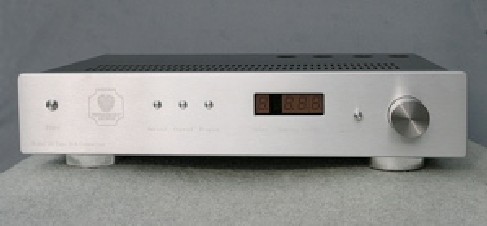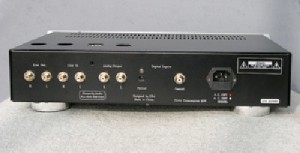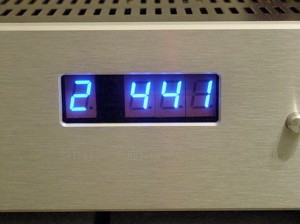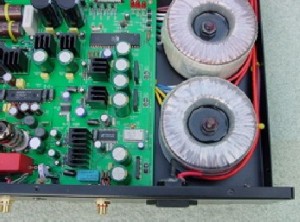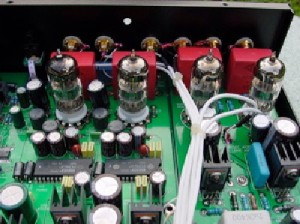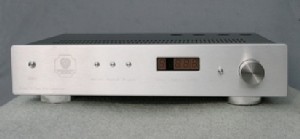Twenty-four years have passed since the introduction of the compact disc player. In 1982, Sony and Phillips brought the first machines to the market place, and provided music listeners with a format that was far more convenient to use than vinyl records, or cassette tapes. The compact disc format was full of promise in those early days, and one company used the advertising slogan of “perfect sound forever.” This was not to be the case, and the early generation machines had several significant flaws in their overall sound. Not to be deterred, audio manufacturers began the process of improving the compact disc player. Every year brought another level of refinement to these machines, and digital audio reproduction became easier to listen to. One startling development was the introduction of the stand-alone digital to analog converter. These converters promised state of the art sound, and were universally embraced as the answer to the limitations of digital reproduction. Audiophiles would carefully select a D to A converter, and then a transport to read the compact disc. The interface between the two units was made with a single digital interconnect. This arrangement of digital reproduction allowed the user to carefully mix and match components to reach their personal nirvana of audio sound. Putting together a digital rig in this manner required a lot of cash, and since digital performance was marching forward at a dizzying rate, many audio enthusiasts could not afford to keep up with the care and feeding of a top of the line digital source.
Specifications:
- DAC and Line Amp in one single package (to drive power amps direct) 24/96 capable, superior performance for 44.1KHz CD’s
- Tube Analog stage in DAC section
- Plays all conventional CD’s (at 44.1KHz) and all 24/96 CD’s
- Digital Display to indicate the Sampling Frequency
- Military Grade 6DJ8 used in both the DAC and
- Line Amp sections (4 pcs)
- Audiophile Grade Volume Control on Solid Stainless Steel knob
- 10 Sections of fully regulated power supplies Separate toroidal transformers for the Digital and Analog sections.
- Separate Line Amp can be used with other external inputs (Tape or Tuner, Etc.) Gain = 16 dB
- DAC Direct Output for use with other Preamps or Control Centers. Burr Brown select grade PCM63P-K used with DF1704 digital filter for the most accurate decoding. 117 or 230 Volt version
- Price $1,490
In the audio world everything is subject to change, and this theorem held true for the digital arena as well. Manufacturers eventually introduced high-end one-box players that rivaled the performance of digital separates, and the audio world embraced them. What audio enthusiasts need to remember is that high quality digital to analog converters still exist, and are a viable option to developing a high performance front end to an audio system.
Monarchy M24 review
Monarchy Audio has quite a history of developing high quality digital components that are economically priced. In the early nineties C.C. Poon began offering a product that is unique in the audio world. Mr. Poon developed the Monarchy Model 22, which is a digital to analog converter and line stage pre amplifier. Other companies have developed DAC’s with variable output stages, which are intended to be fed directly to a power amplifier. However, these pieces were quite finicky, and only matched up well with a limited number of amplifiers. The Monarchy unit is far more sophisticated, and the line stage that is used in these units is a versatile all-around performer. The Monarchy Model 24 is the current version of this design, but differs from its predecessor by using tubes in the output stages of both the DAC and the lines-stage.
The Model 24 reflects Monarchy’s desire to build high quality electronics at a price point that is within the budget of most audio enthusiasts. While it may be reasonably priced, that does not mean that this unit is a second rate piece of electronics. Mr. Poon has made some very interesting design choices in the Model 24 that are the result of many years of experience in the digital audio realm. At the heart of the DAC is the Burr Brown PCM63P-K multibit chip set. The vast majority of current D to A converters that are being sold have a single bit chipsets. However, there are a couple of current multi bit chips still available. These chip sets are significantly more expensive than their single bit counterparts, and are really only found in a few state of the art D to A converters. Burr Brown uses a laser to trim the resistor to each individual bit in order to achieve the highest level of accuracy within the chip. It’s a time consuming process that drives the cost of the chip up, but results in a higher level of dynamic contrast than can be achieved by a single bit processor.
The line-stage of the Model 24 is based on a classic circuit design. The SRPP circuit was originally patented in the 1940 (US 2,310,342) under the name “balanced direct and alternating current amplifier”. This circuit is commonly referred to as the cascoded cathode follower circuit. It is a classic circuit that many electronic designers continue to refine and employ in modern preamplifiers. The SRPP is a basic push-pull circuit that uses a pair of 6922 output tubes. The circuit design allows for the cancellation of even order harmonics that would exist if a single tube were employed in the design. While technically astute readers are capable of an in depth understanding of the application of this circuit, I will say that my listening sessions with the Model 24 indicate that the line-stage portion of this unit is an excellent sounding pre amplifier. A substantial internal power supply section is a mandatory requirement for a high quality piece of audio equipment. Unfortunately, most companies will cut corners on this part of the design in order to hit a desired price point. When the cover is popped off the Model 24, a very impressive sight will be revealed. The left side of the chassis houses a large pair of torrodial transformers. Mr. Poon chose to employ twin transformers in order to isolate the digital and analog sections of the Model 24. If only one transformer were used, it is possible for noise to migrate from the digital stages to the analog portion of the unit. These two transformers are the heart of the Model 24, and without them, the rest of the unit would not be able to reach it’s full potential. There are also ten stages of regulation for the circuit within the power supply design. This allows different parts of the circuit to operate at the correct voltages. This sophisticated regulation system is the reason why the SRPP circuit of the pre-amplifier is able to perform at such a high level.
The parts employed within the Model 24 are responsible for it’s excellent level of performance. Components of this quality often reside in high-end preamplifiers, and their use in the Model 24 is a testament to the lengths that Monarchy will go to achieve high quality audio reproduction. The volume pot is an audiophile grade Alps Electronics unit. The circuit board with in the unit is substantial, with high quality circuit traces. The wiring within the Model 24 is silver coated with Teflon insulation. Quite surprisingly, the coupling capacitors of the linestage are German made WIMA caps. These capacitors are considered to be some of the finest pieces available, and are priced accordingly. The tubes that come supplied with the Model 24 are not the inexpensive, current production tubes that come with many other units. Mr. Poon supplies this piece with two pairs of New Old Stock Phillips 6DJ8 military grade tubes. The Phillips tube is a significant improvement over the average Russian tube that is usually found in components that reside in the sub $2000 price category. Finally, all of this is contained in a stout steel chassis with a thick, brushed aluminum faceplate that gives the Model 24 a classic appearance. The laser inscribed lettering is an elegant touch that has a practical application. Many components have problems with the lettering on the faceplate fading or even wearing away. After a few years of use, the stenciling on the Monarchy piece will look as good as when the unit first came out of the box.
For the majority of my listening sessions I decided to use the Model 24 as a pre-amplifier and a DAC. Although I did originally listen to the unit as a stand alone D to A converter in order to determine it’s performance in the digital domain. So my initial listening sessions required the use of the Electra Print PVA preamplifier. I decided to partner it with a pair of Monarchy SM 70 Pro amplifiers that are still in the house. I felt this would be an opportunity to experience the performance of a complete Monarchy system. The TRL Modified Sony 595 filled the role of a digital transport. The connection to the Model 24 was made with a Monarchy Toslink digital cable. This is an outstanding digital cable, and I wish I could go into greater detail about it. I will say that $49.00 for a cable that performs this well is an absolute steal. The speakers used for this review are the GR Research Paradox 1 monitors. Tara Labs Air 3 interconnects were used between the Model 24 and the SM 70 Pro amplifiers. Finally, a pair of Tara Labs RSC Master Gen II speaker cables completes the connection to the speakers.
When I first received the Model 24 from Monarchy, I was really curious about the performance of the digital side of the unit. Fortunately, the unit is designed with the ability to output a signal from the final analog stages via a pair RCA cables. I installed the Model 24 between the Sony 595 and the Electra-Print PVA pre amplifier. I was very surprised to hear a significant increase in the amount of detail that the Model 24 was able to retrieve from my discs. The TRL modified Sony 595 is a very capable CD player, but it falls behind the Model 24 in regards to the amount of information that is passed through the digital to analog conversion stages. Church, by Lyle Lovett [Joshua Judges Ruth; MCA MCAD-10475] is a piece I have used to evaluate numerous different components over the last several years. It’s a great song with strong gospel and blues influences. When played through the Model 24 there is a significant improvement to the vocal reproduction of Lyle Lovett and the choir singing the back up vocal parts. Lyle’s voice has an increased level of texture and subtle resonance’s that give the performance a realistic feel to it. The background vocalists also exhibited the same level of improvement to their overall presentation. Furthermore, I am able to pick out the individual voices of the choir when they sang in unison. Each member retained their distinct sound, and it became easy to recognize each vocalist during any solo’s they took during the song. Finally, the acoustic signature of the venue became easier to hear with the Model 24 in the system. The reverberation of vocals and instruments took on a natural sounding decay pattern. Overall, I would say that the Model 24 made a significant improvement to the quality of digital reproduction in my system.
I decided to switch musical gears with the next disc selection for this listening session. The Lyle Lovett recording is a pretty slick piece of studio work. Now it is time to move on to a style of music that is raw and powerful sounding. Boom-Boom by John Lee Hooker [Boom-Boom; Point Blank V2-86553] is a classic piece of blues that is capable of unmasking a component’s deficiencies in bass response and the overall quickness of a component.
The Model 24 does a nice job on reproducing the deep resonant qualities of the bass guitar on this piece. Also the speed of the bass line is quick, with no apparent smearing of the individual notes. Richard Cousins is the bass player on this cut, and his performance is tight and fast. It is a real pleasure to listen to his playing through the Model 24. Kevin Hayes and Jimmy Pugh power through this piece with a classic blues sound on drums and keyboard. The Monarchy converter does an outstanding job of recreating the intensity of their playing. Finally, let’s not overlook John Lee’s contribution on vocals of this track. The bad man of blues sounds down right nasty on this song. His deep, resonant voice has a rough edge to it that clearly comes through on this DAC. The Model 24 shows itself to be an excellent all-around performer. As a stand alone digital to analog converter I could not uncover any glaring shortcomings in its performance. If you hope to obtain a superior unit than the Monarchy DAC, then be prepared to layout a significant amount of cash.
Once I determined the capabilities of the Model 24 as a digital to analog converter, the next step is to enable the pre-amplifier section of the unit. So I removed the Electra-Print preamplifier, and one pair of Tara Labs interconnects. A swap of interconnects on the back of the Model 24 enables the line-stage portion, and I was ready to continue my evaluation process. I decided to replay the two previous music selections in order to determine what changes will occur from employing the linestage. It is important to remember that the Electra-Print is a passive pre-amplifier built around a pair of nickel core step up transformers. It has a different set of sonic characteristics than a conventional active gain preamplifier. Since the Electra-Print and Model 24 reside in the world of sub thousand dollar preamplifiers, both will exhibit some limitations to their overall performance. This proved to be true in this comparison between the two units.
I decided to replay Church by Lyle Lovett to begin this part of the evaluation. There is a noticeable difference in the presentation of this song when the Model 24 line-stage is employed. I hear a slight loss of transparency with the Monarchy piece in the system. This is to be expected since the Electra-Print excels at a transparent presentation. The music also takes on a softer sound when the Model 24 line-stage is engaged. This typical of most tube pre-amplifiers, and there is nothing inherently wrong with this sound. The positive aspect of this kind of sound is that listener fatigue is greatly reduced, if not altogether eliminated. However, there are improvements to the size of the soundstage that more than offset the limitations of the Model 24 linestage. I was pleasantly surprised by how the depth of the soundstage increased when listening through this unit. Not only did the soundstage deepen behind the plane of the speakers, it also projected performers farther into the room. Another benefit to using the Model 24 line-stage is how the instruments and voices appeared to occupy a definite space within the soundstage. The Monarchy piece does a better job than the Electra-Print in creating the illusion of a musical performance.
The Model 24 is an active pre-amplifier and offers the benefit of 16 db of gain to it’s output signal. The Electra-Print is a passive preamplifier, and by its very nature is unable to boost the outgoing signal. Instead it attenuates the signal coming from the source unit in order to function as a volume control. The transformers in the PVA convert the incoming signal to a high current/low voltage format, which is better suited to driving a power amplifier. So when I listened to Boom-Boom by John Lee Hooker with the Model 24 in place, I immediately noticed an increased level of dynamic contrast in the performance. The loud passages of music had more volume and snap to them. The drum kit had a real kick to it, and the snap of the drumheads was definitely improved. I also noticed that the bass guitar had a deeper and more vibrant sound to it. Overall, I would say that this song has a lot more substance to it when the Model 24 linestage is being employed. It really highlighted all the aspects of the music that people enjoy about the blues.
Final thoughts about Monarchy M24 DAC
My experience with the Model 24 proves that high-end digital performance is available to all audio enthusiasts, not just those with deep pockets. It is not necessary to obtain a second mortgage on the homestead in order to enjoy the sonic benefits of a tube-based digital to analog converter. Throw in the fully active tube line-stage that may very well outperform your current unit, and you end up with a pretty impressive audio package. The digital to analog stage of the Model 24 would provide a significant improvement to systems that do not employ a state of the art single box CD player. The M 24 is also quite competitive in the current DAC arena, and will hold it’s own against all comers. Either way, the performance of the digital side of the Model 24 is well worth the selling price of this unit. The line-stage inside the M24 is a real gem, and it would be a mistake to assume it is not a true high-end pre-amplifier due to its modest price. The Model 24 has a huge soundstage, and provides a touch of warmth to the sound that is quite easy to listen to. The combination of the Monarchy SM 70 PRO amplifiers with the Model 24 provided me with many evenings of sonic bliss. In the past I have listened to some mega-dollar systems that were unable to recreate the level of realism and refinement that the Monarchy stack is capable of. So get your hands on one of these units, and be prepared to be happily surprised by it’s performance. The Model 24 is one of those great buys in today’s audio marketplace.
Associated Equipment:
- Tube Research Labs modified Sony SCD-595
- Monarchy SM 70 Pro amplifiers
- GR Research Paradox One speakers
- Tara Labs Air 3 interconnects
- Tara Labs RSC Master Gen II speaker wire
- Audio Magic Extreme power cords
external link: http://www.monarchyaudio.com/
from affordableaudio, By John Hoffman
